Investment Appraisal Techniques for ABC plc: A Financial Report
VerifiedAdded on 2023/01/13
|8
|1436
|93
Report
AI Summary
This report provides a financial analysis of two potential projects for ABC plc, focusing on investment appraisal techniques. It begins with an introduction to capital budgeting and the importance of decision-making in business organizations. The core of the report assesses the viability of each project (Motor Software and Hardware) using Net Present Value (NPV) and payback period methods. The NPV calculations show positive values for both projects, with the Hardware project having a higher NPV. The payback period analysis indicates that both projects recover their initial investment in 3.2 years. The report recommends the Hardware project due to its higher NPV, emphasizing the importance of considering both financial and non-financial factors in investment decisions. The report concludes by highlighting the significance of project evaluation methods for businesses, stressing the need for a comprehensive approach to ensure sound investment choices and maximize profitability. References to relevant academic sources are also included.

BUSINESS DECISION MAKING
Paraphrase This Document
Need a fresh take? Get an instant paraphrase of this document with our AI Paraphraser
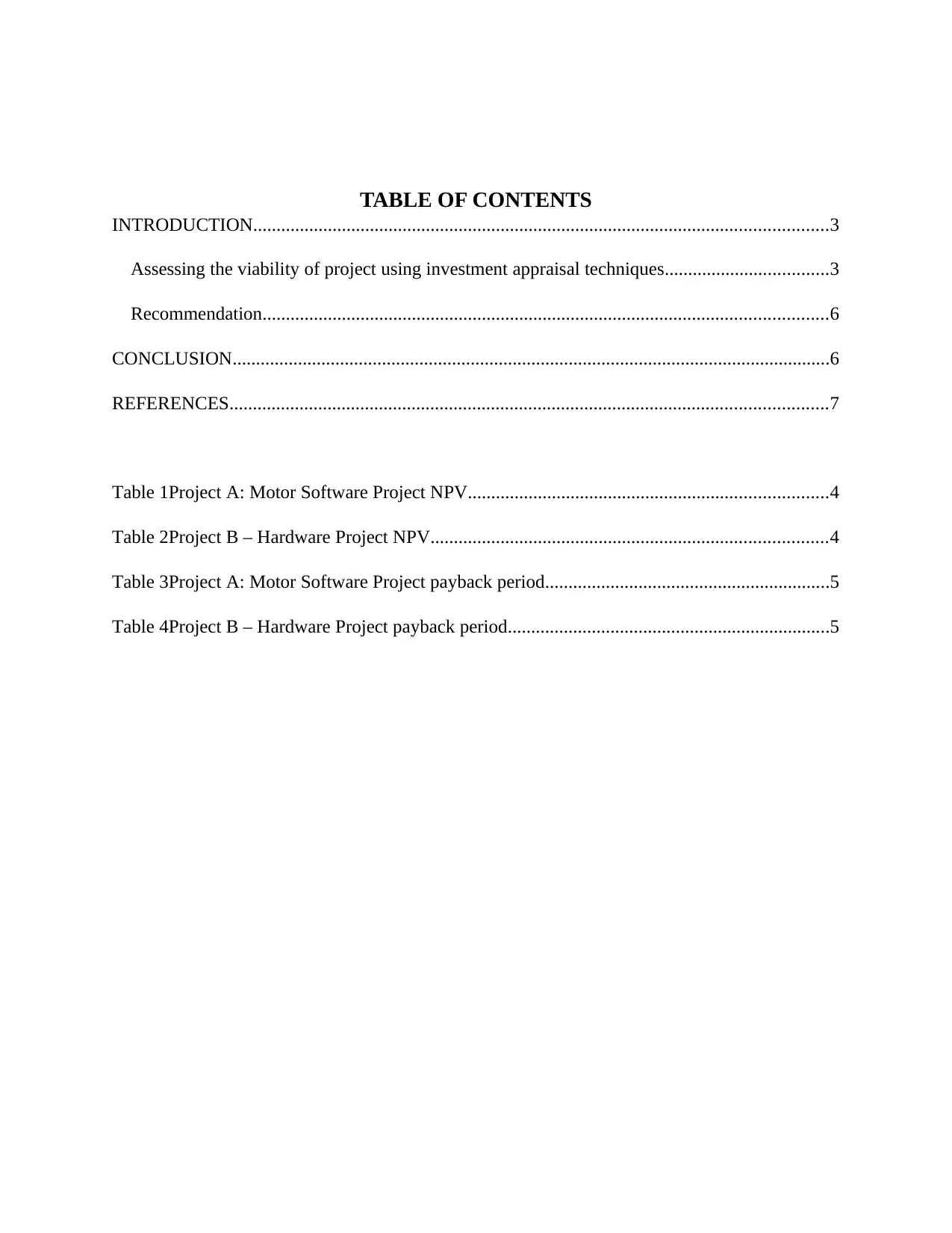
TABLE OF CONTENTS
INTRODUCTION...........................................................................................................................3
Assessing the viability of project using investment appraisal techniques...................................3
Recommendation.........................................................................................................................6
CONCLUSION................................................................................................................................6
REFERENCES................................................................................................................................7
Table 1Project A: Motor Software Project NPV.............................................................................4
Table 2Project B – Hardware Project NPV.....................................................................................4
Table 3Project A: Motor Software Project payback period.............................................................5
Table 4Project B – Hardware Project payback period.....................................................................5
INTRODUCTION...........................................................................................................................3
Assessing the viability of project using investment appraisal techniques...................................3
Recommendation.........................................................................................................................6
CONCLUSION................................................................................................................................6
REFERENCES................................................................................................................................7
Table 1Project A: Motor Software Project NPV.............................................................................4
Table 2Project B – Hardware Project NPV.....................................................................................4
Table 3Project A: Motor Software Project payback period.............................................................5
Table 4Project B – Hardware Project payback period.....................................................................5
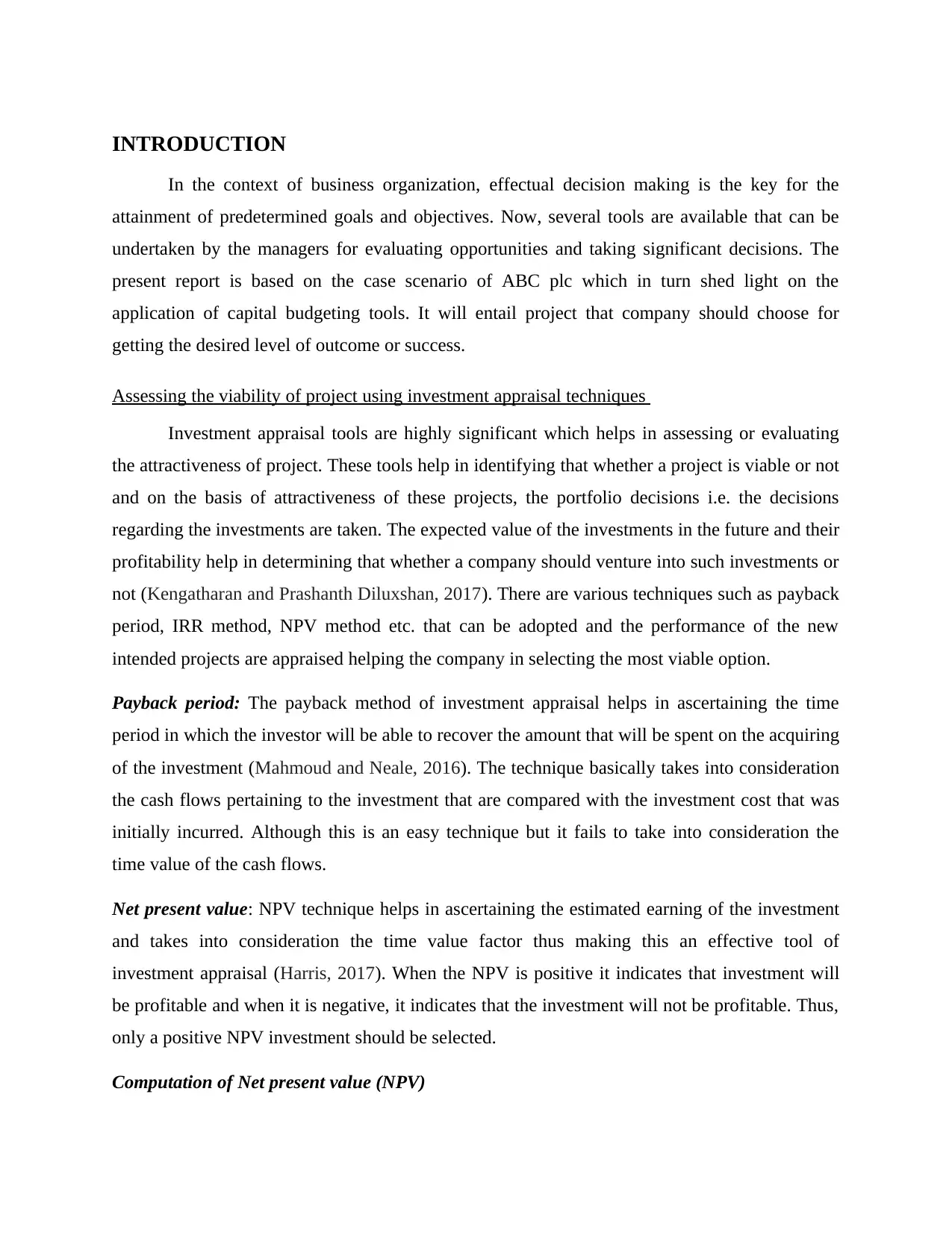
INTRODUCTION
In the context of business organization, effectual decision making is the key for the
attainment of predetermined goals and objectives. Now, several tools are available that can be
undertaken by the managers for evaluating opportunities and taking significant decisions. The
present report is based on the case scenario of ABC plc which in turn shed light on the
application of capital budgeting tools. It will entail project that company should choose for
getting the desired level of outcome or success.
Assessing the viability of project using investment appraisal techniques
Investment appraisal tools are highly significant which helps in assessing or evaluating
the attractiveness of project. These tools help in identifying that whether a project is viable or not
and on the basis of attractiveness of these projects, the portfolio decisions i.e. the decisions
regarding the investments are taken. The expected value of the investments in the future and their
profitability help in determining that whether a company should venture into such investments or
not (Kengatharan and Prashanth Diluxshan, 2017). There are various techniques such as payback
period, IRR method, NPV method etc. that can be adopted and the performance of the new
intended projects are appraised helping the company in selecting the most viable option.
Payback period: The payback method of investment appraisal helps in ascertaining the time
period in which the investor will be able to recover the amount that will be spent on the acquiring
of the investment (Mahmoud and Neale, 2016). The technique basically takes into consideration
the cash flows pertaining to the investment that are compared with the investment cost that was
initially incurred. Although this is an easy technique but it fails to take into consideration the
time value of the cash flows.
Net present value: NPV technique helps in ascertaining the estimated earning of the investment
and takes into consideration the time value factor thus making this an effective tool of
investment appraisal (Harris, 2017). When the NPV is positive it indicates that investment will
be profitable and when it is negative, it indicates that the investment will not be profitable. Thus,
only a positive NPV investment should be selected.
Computation of Net present value (NPV)
In the context of business organization, effectual decision making is the key for the
attainment of predetermined goals and objectives. Now, several tools are available that can be
undertaken by the managers for evaluating opportunities and taking significant decisions. The
present report is based on the case scenario of ABC plc which in turn shed light on the
application of capital budgeting tools. It will entail project that company should choose for
getting the desired level of outcome or success.
Assessing the viability of project using investment appraisal techniques
Investment appraisal tools are highly significant which helps in assessing or evaluating
the attractiveness of project. These tools help in identifying that whether a project is viable or not
and on the basis of attractiveness of these projects, the portfolio decisions i.e. the decisions
regarding the investments are taken. The expected value of the investments in the future and their
profitability help in determining that whether a company should venture into such investments or
not (Kengatharan and Prashanth Diluxshan, 2017). There are various techniques such as payback
period, IRR method, NPV method etc. that can be adopted and the performance of the new
intended projects are appraised helping the company in selecting the most viable option.
Payback period: The payback method of investment appraisal helps in ascertaining the time
period in which the investor will be able to recover the amount that will be spent on the acquiring
of the investment (Mahmoud and Neale, 2016). The technique basically takes into consideration
the cash flows pertaining to the investment that are compared with the investment cost that was
initially incurred. Although this is an easy technique but it fails to take into consideration the
time value of the cash flows.
Net present value: NPV technique helps in ascertaining the estimated earning of the investment
and takes into consideration the time value factor thus making this an effective tool of
investment appraisal (Harris, 2017). When the NPV is positive it indicates that investment will
be profitable and when it is negative, it indicates that the investment will not be profitable. Thus,
only a positive NPV investment should be selected.
Computation of Net present value (NPV)
⊘ This is a preview!⊘
Do you want full access?
Subscribe today to unlock all pages.

Trusted by 1+ million students worldwide
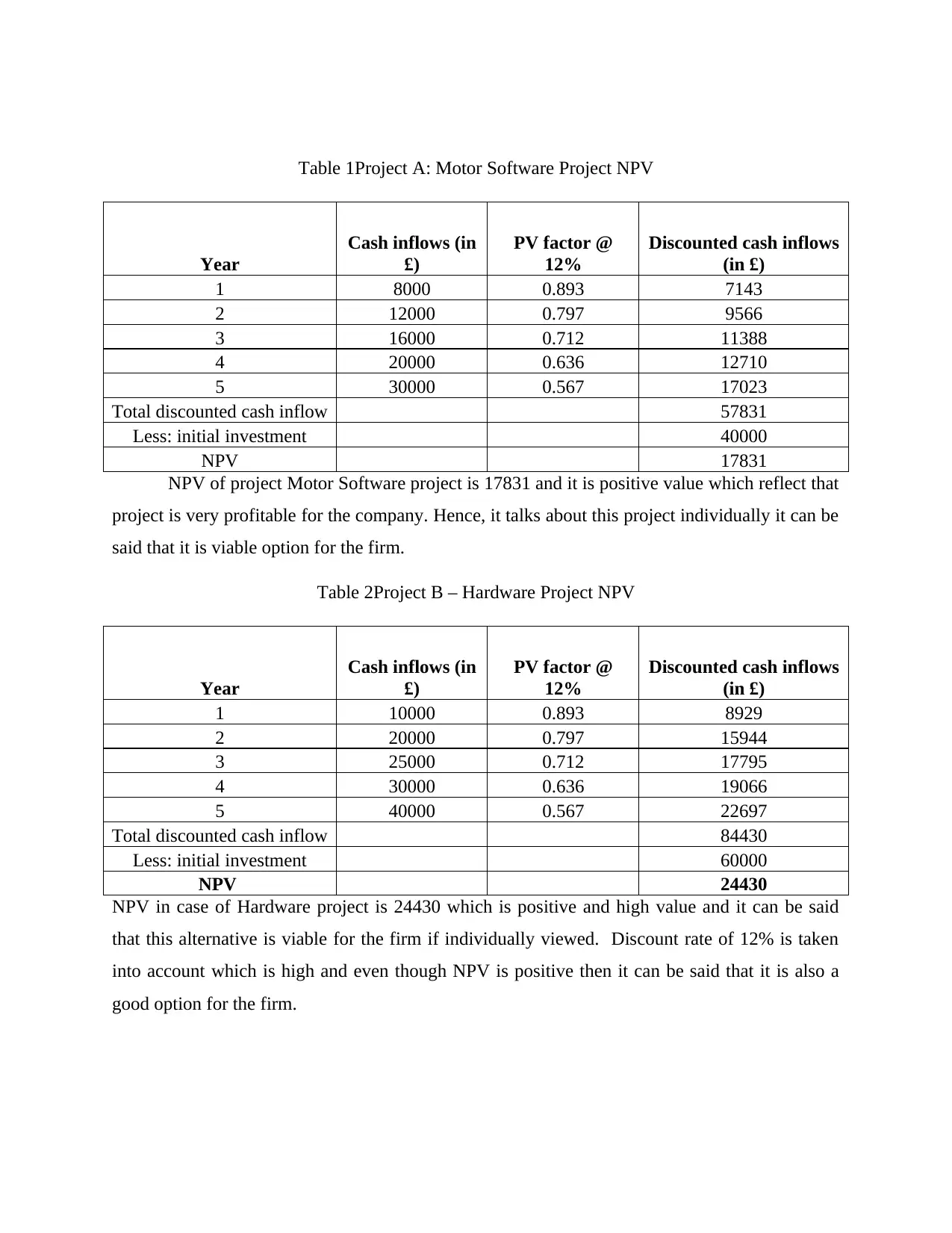
Table 1Project A: Motor Software Project NPV
Year
Cash inflows (in
£)
PV factor @
12%
Discounted cash inflows
(in £)
1 8000 0.893 7143
2 12000 0.797 9566
3 16000 0.712 11388
4 20000 0.636 12710
5 30000 0.567 17023
Total discounted cash inflow 57831
Less: initial investment 40000
NPV 17831
NPV of project Motor Software project is 17831 and it is positive value which reflect that
project is very profitable for the company. Hence, it talks about this project individually it can be
said that it is viable option for the firm.
Table 2Project B – Hardware Project NPV
Year
Cash inflows (in
£)
PV factor @
12%
Discounted cash inflows
(in £)
1 10000 0.893 8929
2 20000 0.797 15944
3 25000 0.712 17795
4 30000 0.636 19066
5 40000 0.567 22697
Total discounted cash inflow 84430
Less: initial investment 60000
NPV 24430
NPV in case of Hardware project is 24430 which is positive and high value and it can be said
that this alternative is viable for the firm if individually viewed. Discount rate of 12% is taken
into account which is high and even though NPV is positive then it can be said that it is also a
good option for the firm.
Year
Cash inflows (in
£)
PV factor @
12%
Discounted cash inflows
(in £)
1 8000 0.893 7143
2 12000 0.797 9566
3 16000 0.712 11388
4 20000 0.636 12710
5 30000 0.567 17023
Total discounted cash inflow 57831
Less: initial investment 40000
NPV 17831
NPV of project Motor Software project is 17831 and it is positive value which reflect that
project is very profitable for the company. Hence, it talks about this project individually it can be
said that it is viable option for the firm.
Table 2Project B – Hardware Project NPV
Year
Cash inflows (in
£)
PV factor @
12%
Discounted cash inflows
(in £)
1 10000 0.893 8929
2 20000 0.797 15944
3 25000 0.712 17795
4 30000 0.636 19066
5 40000 0.567 22697
Total discounted cash inflow 84430
Less: initial investment 60000
NPV 24430
NPV in case of Hardware project is 24430 which is positive and high value and it can be said
that this alternative is viable for the firm if individually viewed. Discount rate of 12% is taken
into account which is high and even though NPV is positive then it can be said that it is also a
good option for the firm.
Paraphrase This Document
Need a fresh take? Get an instant paraphrase of this document with our AI Paraphraser
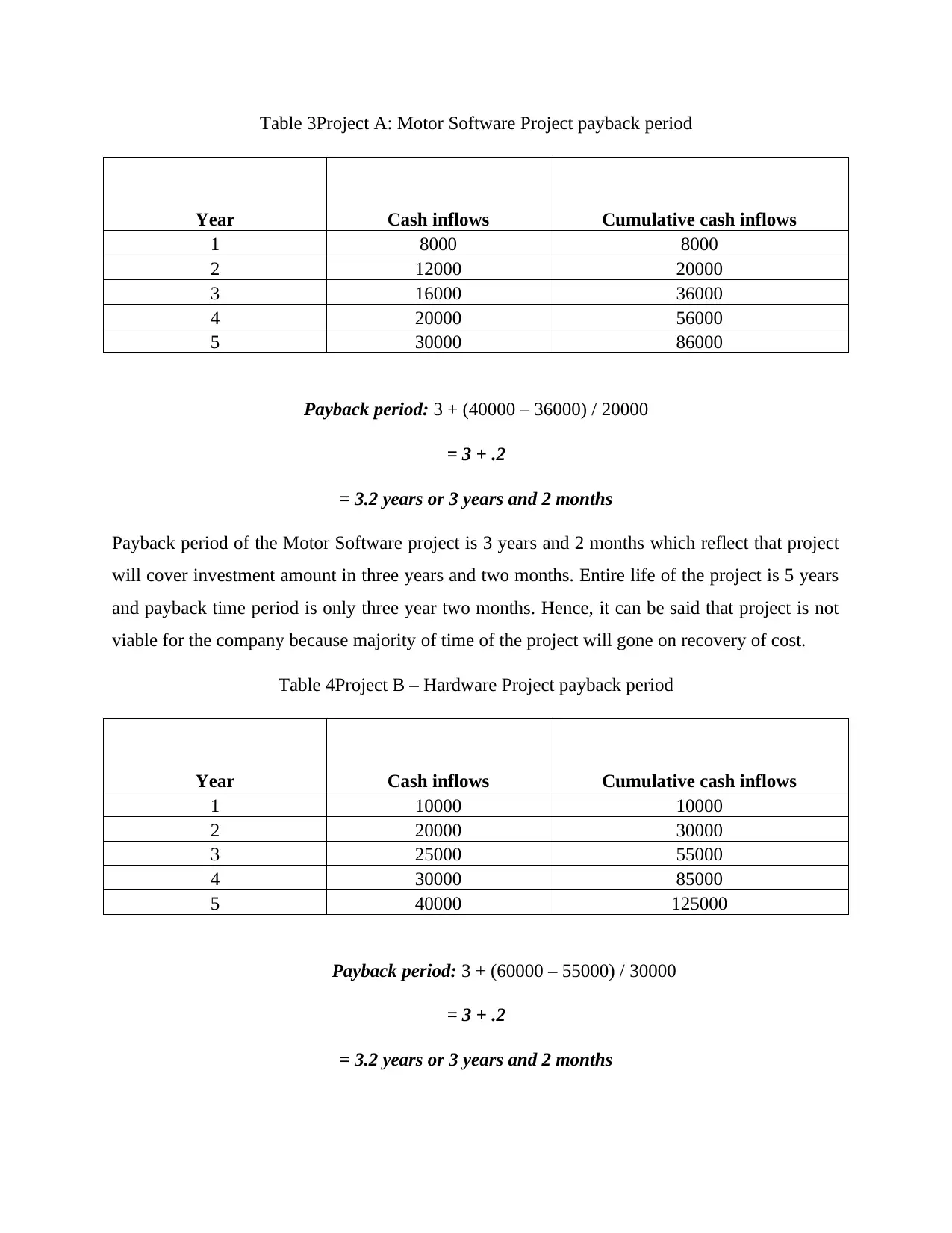
Table 3Project A: Motor Software Project payback period
Year Cash inflows Cumulative cash inflows
1 8000 8000
2 12000 20000
3 16000 36000
4 20000 56000
5 30000 86000
Payback period: 3 + (40000 – 36000) / 20000
= 3 + .2
= 3.2 years or 3 years and 2 months
Payback period of the Motor Software project is 3 years and 2 months which reflect that project
will cover investment amount in three years and two months. Entire life of the project is 5 years
and payback time period is only three year two months. Hence, it can be said that project is not
viable for the company because majority of time of the project will gone on recovery of cost.
Table 4Project B – Hardware Project payback period
Year Cash inflows Cumulative cash inflows
1 10000 10000
2 20000 30000
3 25000 55000
4 30000 85000
5 40000 125000
Payback period: 3 + (60000 – 55000) / 30000
= 3 + .2
= 3.2 years or 3 years and 2 months
Year Cash inflows Cumulative cash inflows
1 8000 8000
2 12000 20000
3 16000 36000
4 20000 56000
5 30000 86000
Payback period: 3 + (40000 – 36000) / 20000
= 3 + .2
= 3.2 years or 3 years and 2 months
Payback period of the Motor Software project is 3 years and 2 months which reflect that project
will cover investment amount in three years and two months. Entire life of the project is 5 years
and payback time period is only three year two months. Hence, it can be said that project is not
viable for the company because majority of time of the project will gone on recovery of cost.
Table 4Project B – Hardware Project payback period
Year Cash inflows Cumulative cash inflows
1 10000 10000
2 20000 30000
3 25000 55000
4 30000 85000
5 40000 125000
Payback period: 3 + (60000 – 55000) / 30000
= 3 + .2
= 3.2 years or 3 years and 2 months
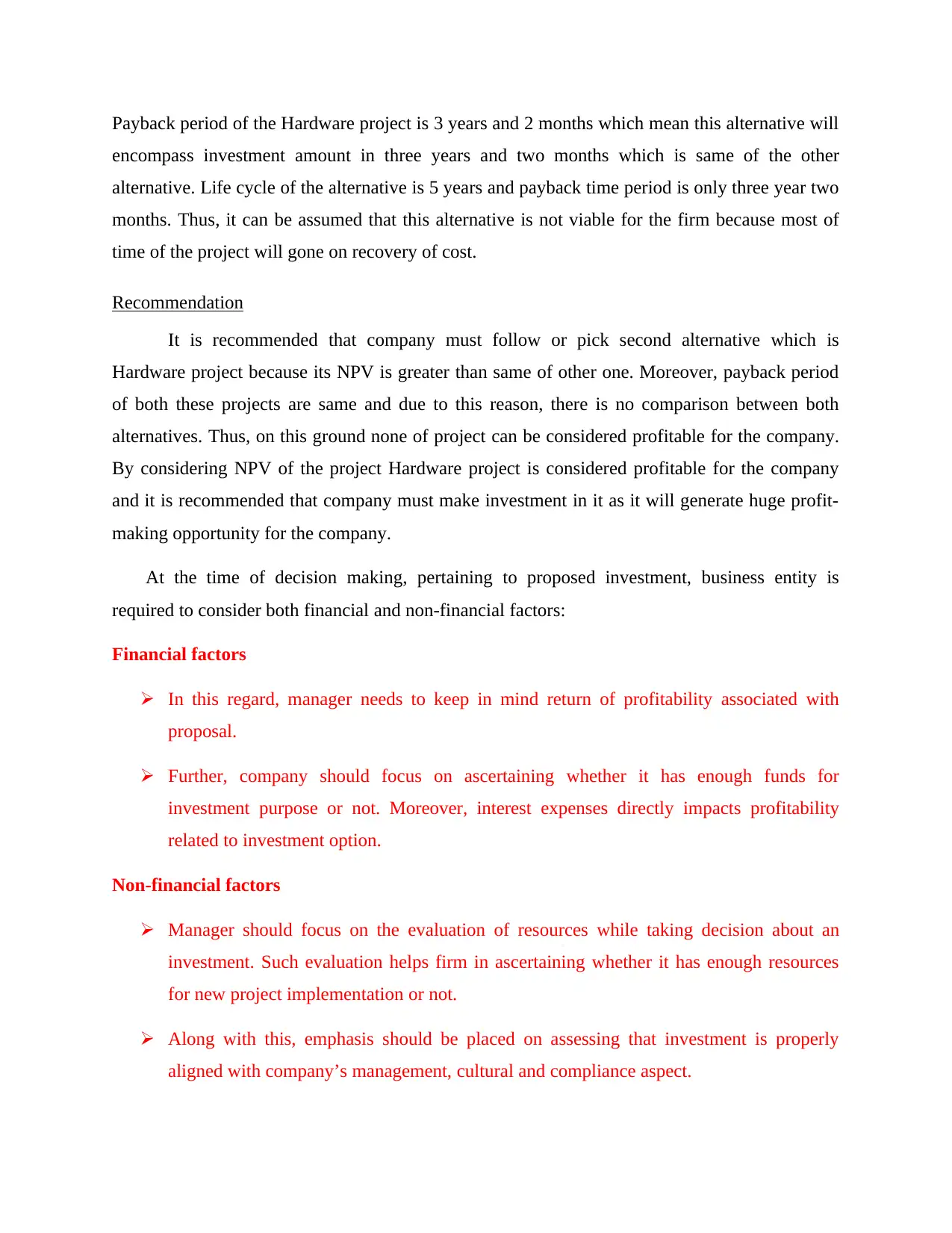
Payback period of the Hardware project is 3 years and 2 months which mean this alternative will
encompass investment amount in three years and two months which is same of the other
alternative. Life cycle of the alternative is 5 years and payback time period is only three year two
months. Thus, it can be assumed that this alternative is not viable for the firm because most of
time of the project will gone on recovery of cost.
Recommendation
It is recommended that company must follow or pick second alternative which is
Hardware project because its NPV is greater than same of other one. Moreover, payback period
of both these projects are same and due to this reason, there is no comparison between both
alternatives. Thus, on this ground none of project can be considered profitable for the company.
By considering NPV of the project Hardware project is considered profitable for the company
and it is recommended that company must make investment in it as it will generate huge profit-
making opportunity for the company.
At the time of decision making, pertaining to proposed investment, business entity is
required to consider both financial and non-financial factors:
Financial factors
In this regard, manager needs to keep in mind return of profitability associated with
proposal.
Further, company should focus on ascertaining whether it has enough funds for
investment purpose or not. Moreover, interest expenses directly impacts profitability
related to investment option.
Non-financial factors
Manager should focus on the evaluation of resources while taking decision about an
investment. Such evaluation helps firm in ascertaining whether it has enough resources
for new project implementation or not.
Along with this, emphasis should be placed on assessing that investment is properly
aligned with company’s management, cultural and compliance aspect.
encompass investment amount in three years and two months which is same of the other
alternative. Life cycle of the alternative is 5 years and payback time period is only three year two
months. Thus, it can be assumed that this alternative is not viable for the firm because most of
time of the project will gone on recovery of cost.
Recommendation
It is recommended that company must follow or pick second alternative which is
Hardware project because its NPV is greater than same of other one. Moreover, payback period
of both these projects are same and due to this reason, there is no comparison between both
alternatives. Thus, on this ground none of project can be considered profitable for the company.
By considering NPV of the project Hardware project is considered profitable for the company
and it is recommended that company must make investment in it as it will generate huge profit-
making opportunity for the company.
At the time of decision making, pertaining to proposed investment, business entity is
required to consider both financial and non-financial factors:
Financial factors
In this regard, manager needs to keep in mind return of profitability associated with
proposal.
Further, company should focus on ascertaining whether it has enough funds for
investment purpose or not. Moreover, interest expenses directly impacts profitability
related to investment option.
Non-financial factors
Manager should focus on the evaluation of resources while taking decision about an
investment. Such evaluation helps firm in ascertaining whether it has enough resources
for new project implementation or not.
Along with this, emphasis should be placed on assessing that investment is properly
aligned with company’s management, cultural and compliance aspect.
⊘ This is a preview!⊘
Do you want full access?
Subscribe today to unlock all pages.

Trusted by 1+ million students worldwide

CONCLUSION
On the basis of above discussion, it is concluded that there is huge importance of the
project evaluation methods for the business firms. This is because any project cannot be picked
just be looking at its cash flows. Project needs to be evaluated from multiple angels before
making any final decision. Specific project may perform good and bad on particular parameter
and due to this reason by considering multiple factors specific one must be selected by the firm
so that right decision can be taken in respect to making investment in any project.
On the basis of above discussion, it is concluded that there is huge importance of the
project evaluation methods for the business firms. This is because any project cannot be picked
just be looking at its cash flows. Project needs to be evaluated from multiple angels before
making any final decision. Specific project may perform good and bad on particular parameter
and due to this reason by considering multiple factors specific one must be selected by the firm
so that right decision can be taken in respect to making investment in any project.
Paraphrase This Document
Need a fresh take? Get an instant paraphrase of this document with our AI Paraphraser
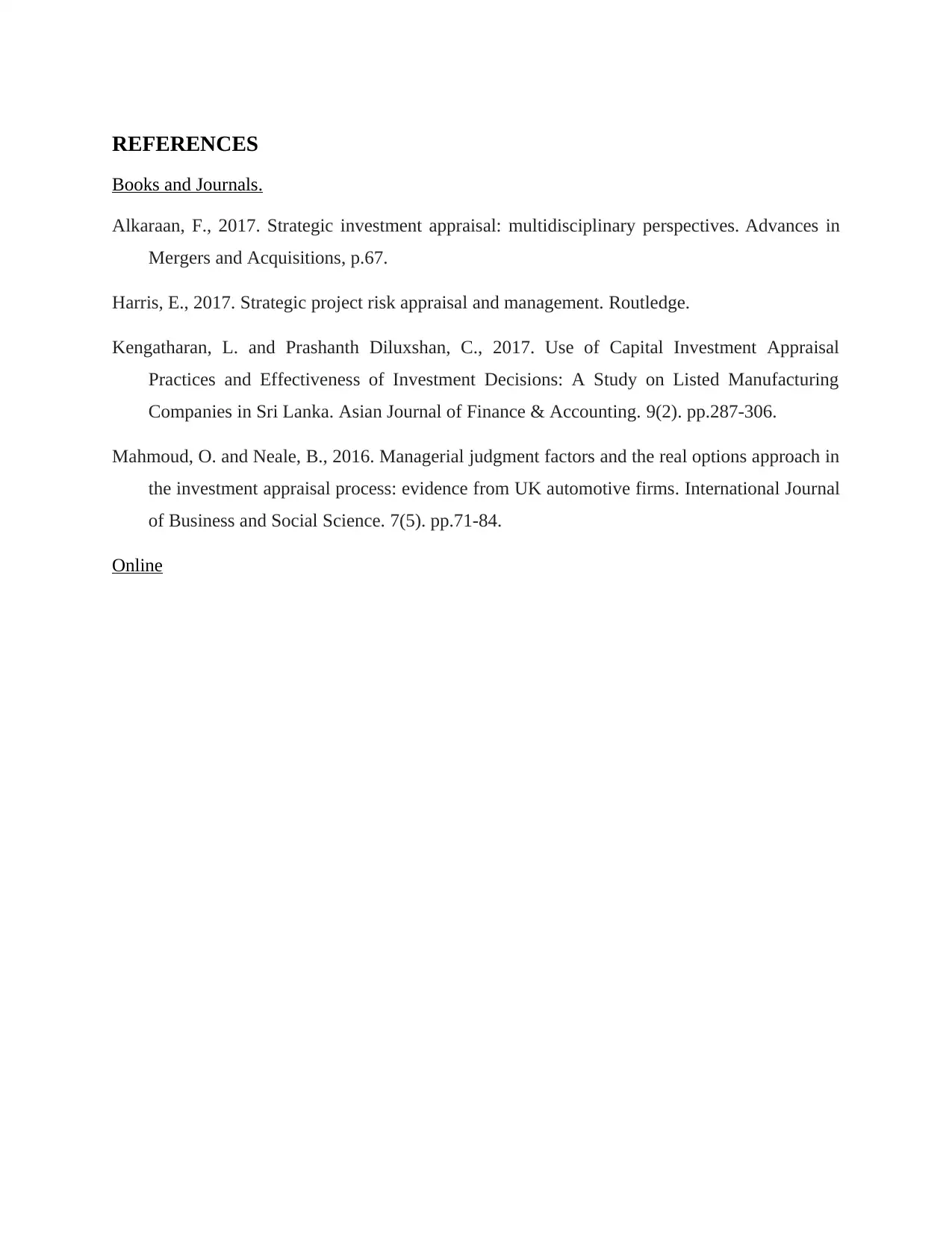
REFERENCES
Books and Journals.
Alkaraan, F., 2017. Strategic investment appraisal: multidisciplinary perspectives. Advances in
Mergers and Acquisitions, p.67.
Harris, E., 2017. Strategic project risk appraisal and management. Routledge.
Kengatharan, L. and Prashanth Diluxshan, C., 2017. Use of Capital Investment Appraisal
Practices and Effectiveness of Investment Decisions: A Study on Listed Manufacturing
Companies in Sri Lanka. Asian Journal of Finance & Accounting. 9(2). pp.287-306.
Mahmoud, O. and Neale, B., 2016. Managerial judgment factors and the real options approach in
the investment appraisal process: evidence from UK automotive firms. International Journal
of Business and Social Science. 7(5). pp.71-84.
Online
Books and Journals.
Alkaraan, F., 2017. Strategic investment appraisal: multidisciplinary perspectives. Advances in
Mergers and Acquisitions, p.67.
Harris, E., 2017. Strategic project risk appraisal and management. Routledge.
Kengatharan, L. and Prashanth Diluxshan, C., 2017. Use of Capital Investment Appraisal
Practices and Effectiveness of Investment Decisions: A Study on Listed Manufacturing
Companies in Sri Lanka. Asian Journal of Finance & Accounting. 9(2). pp.287-306.
Mahmoud, O. and Neale, B., 2016. Managerial judgment factors and the real options approach in
the investment appraisal process: evidence from UK automotive firms. International Journal
of Business and Social Science. 7(5). pp.71-84.
Online
1 out of 8
Related Documents
Your All-in-One AI-Powered Toolkit for Academic Success.
+13062052269
info@desklib.com
Available 24*7 on WhatsApp / Email
![[object Object]](/_next/static/media/star-bottom.7253800d.svg)
Unlock your academic potential
Copyright © 2020–2025 A2Z Services. All Rights Reserved. Developed and managed by ZUCOL.





